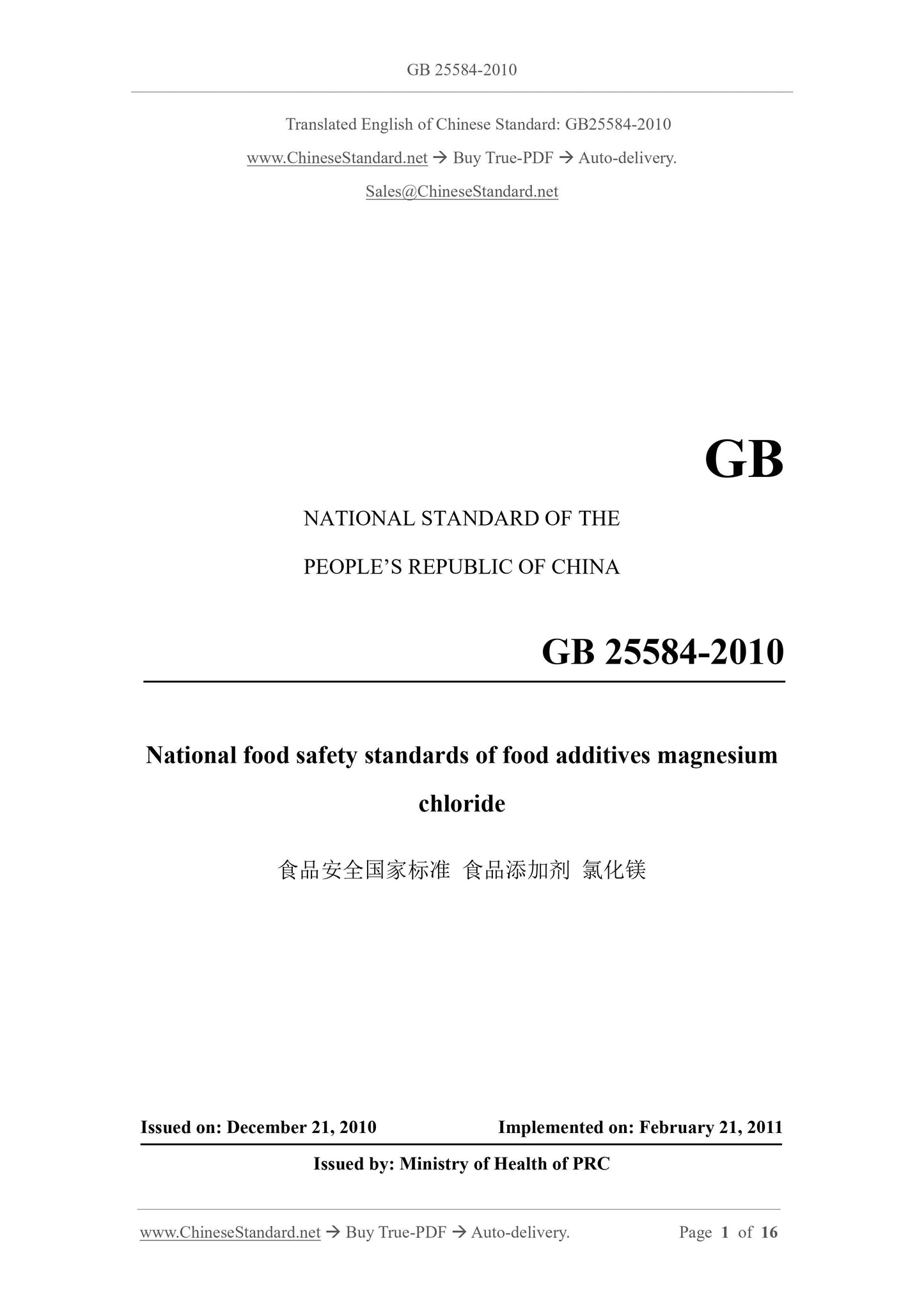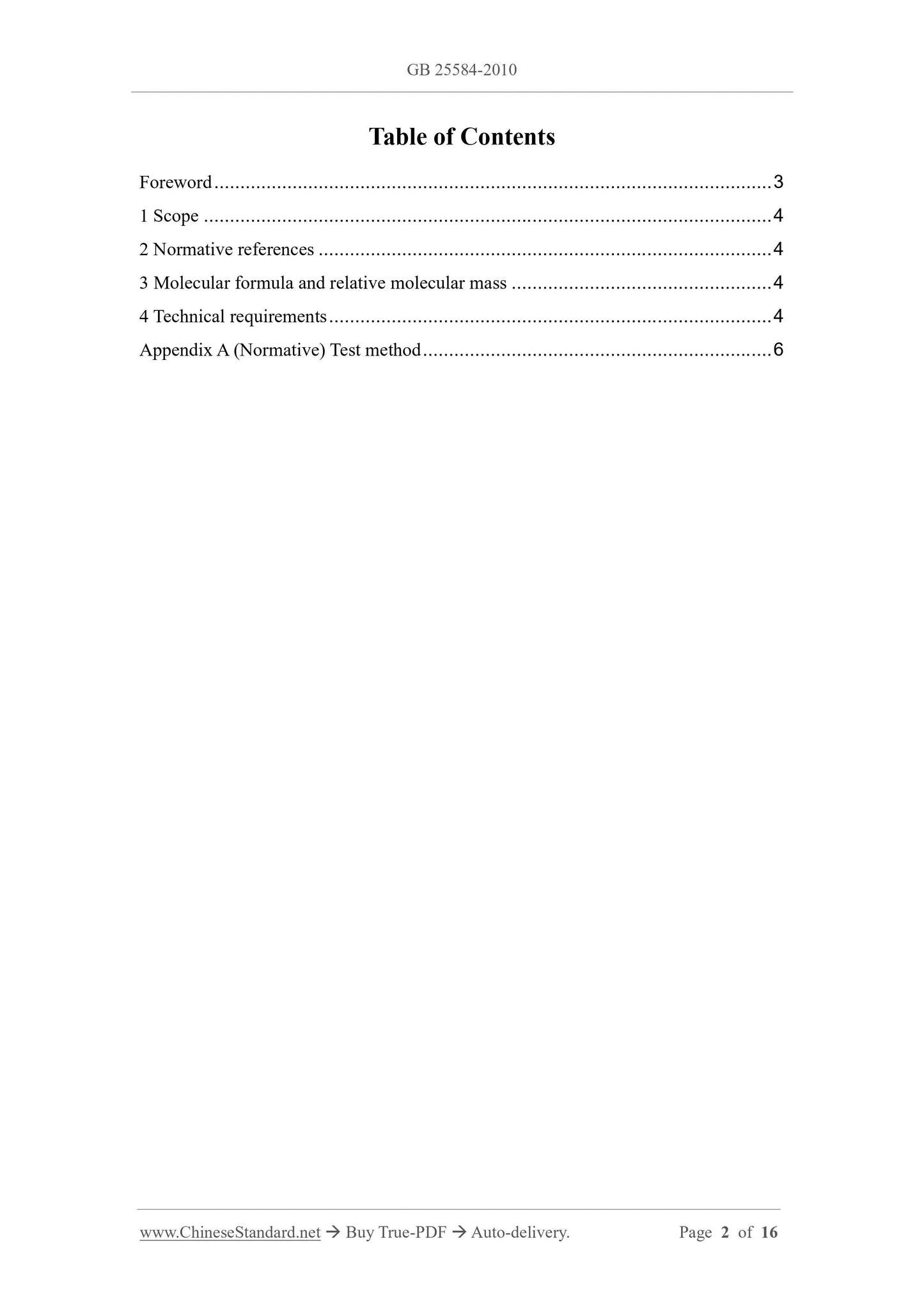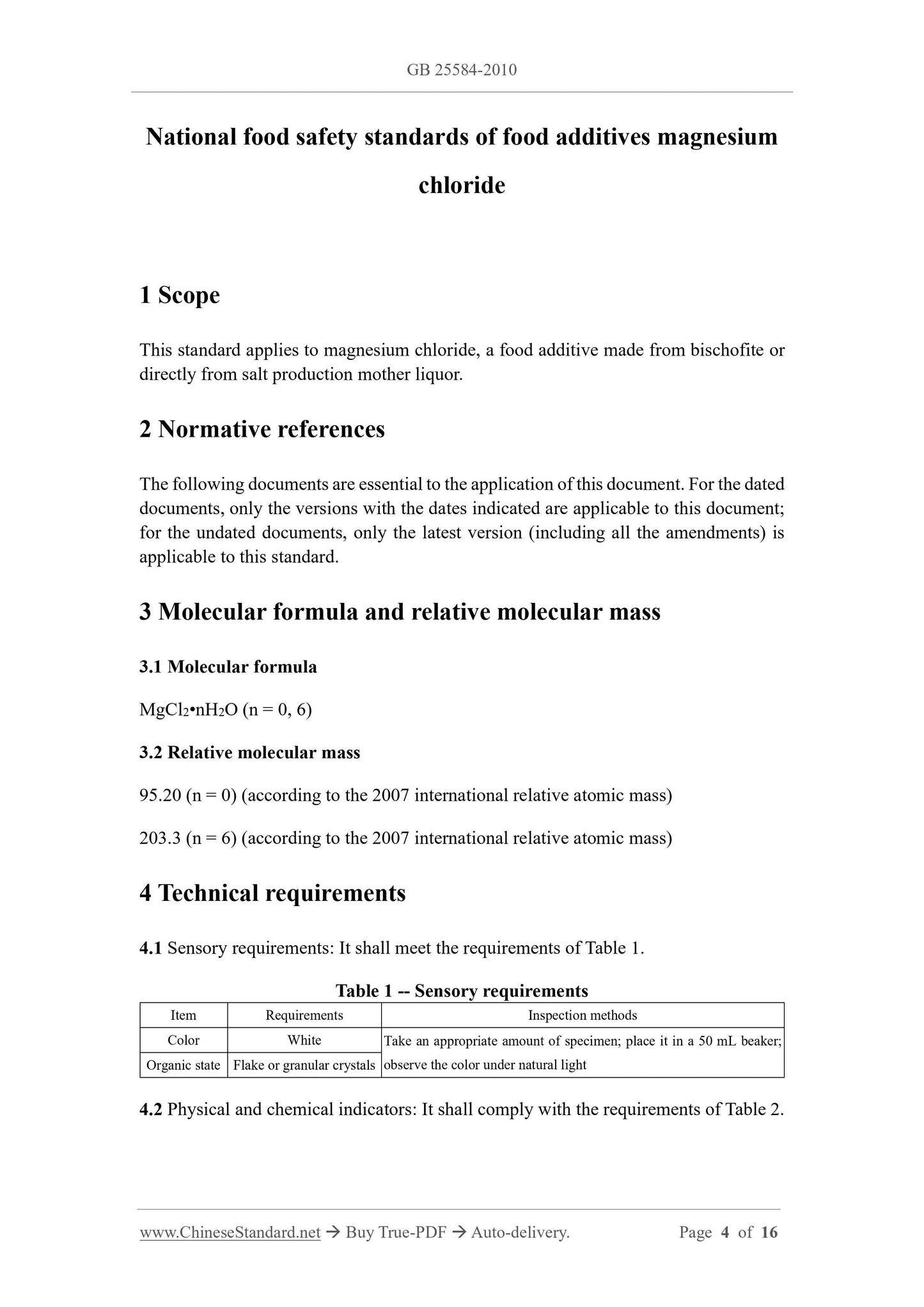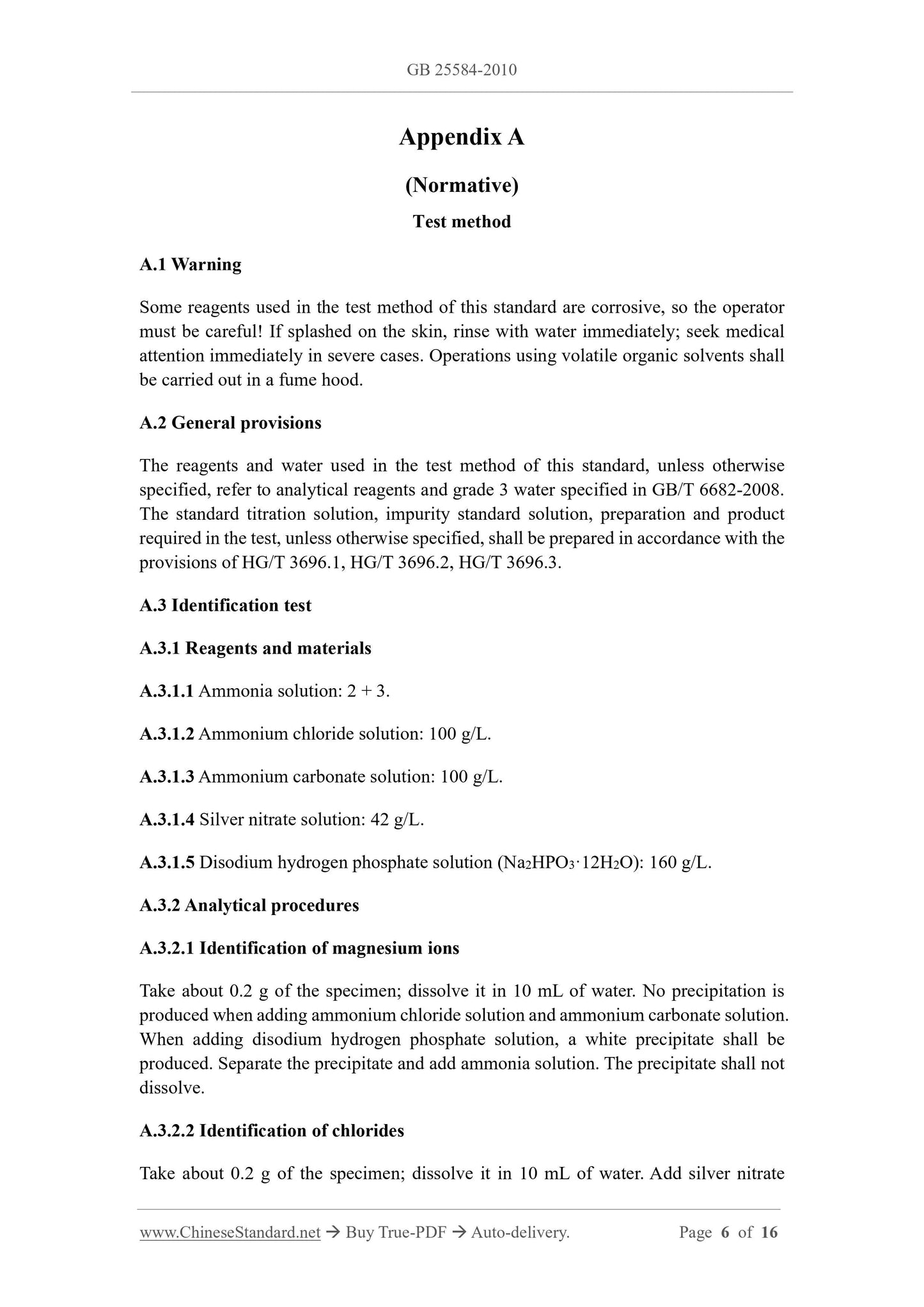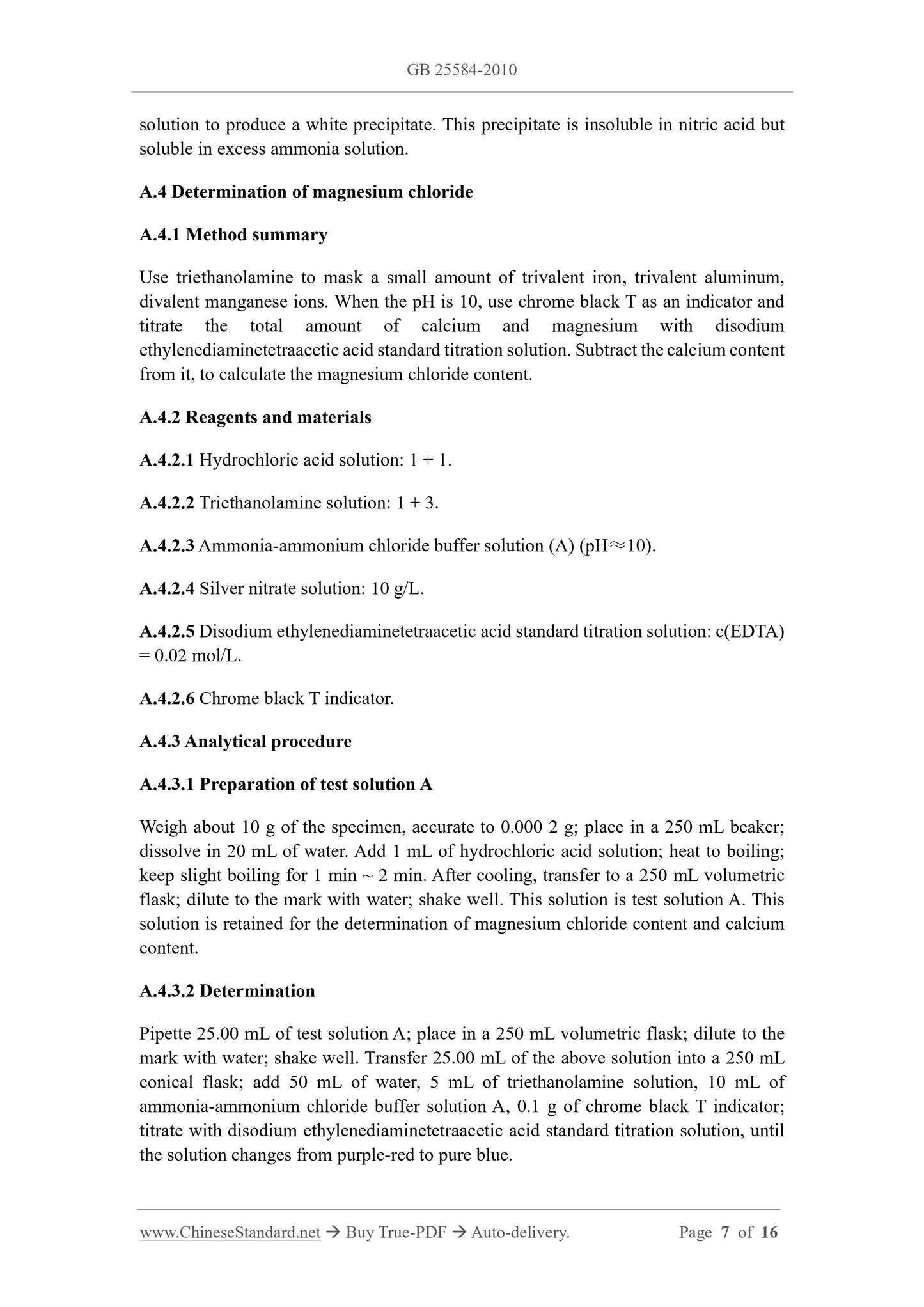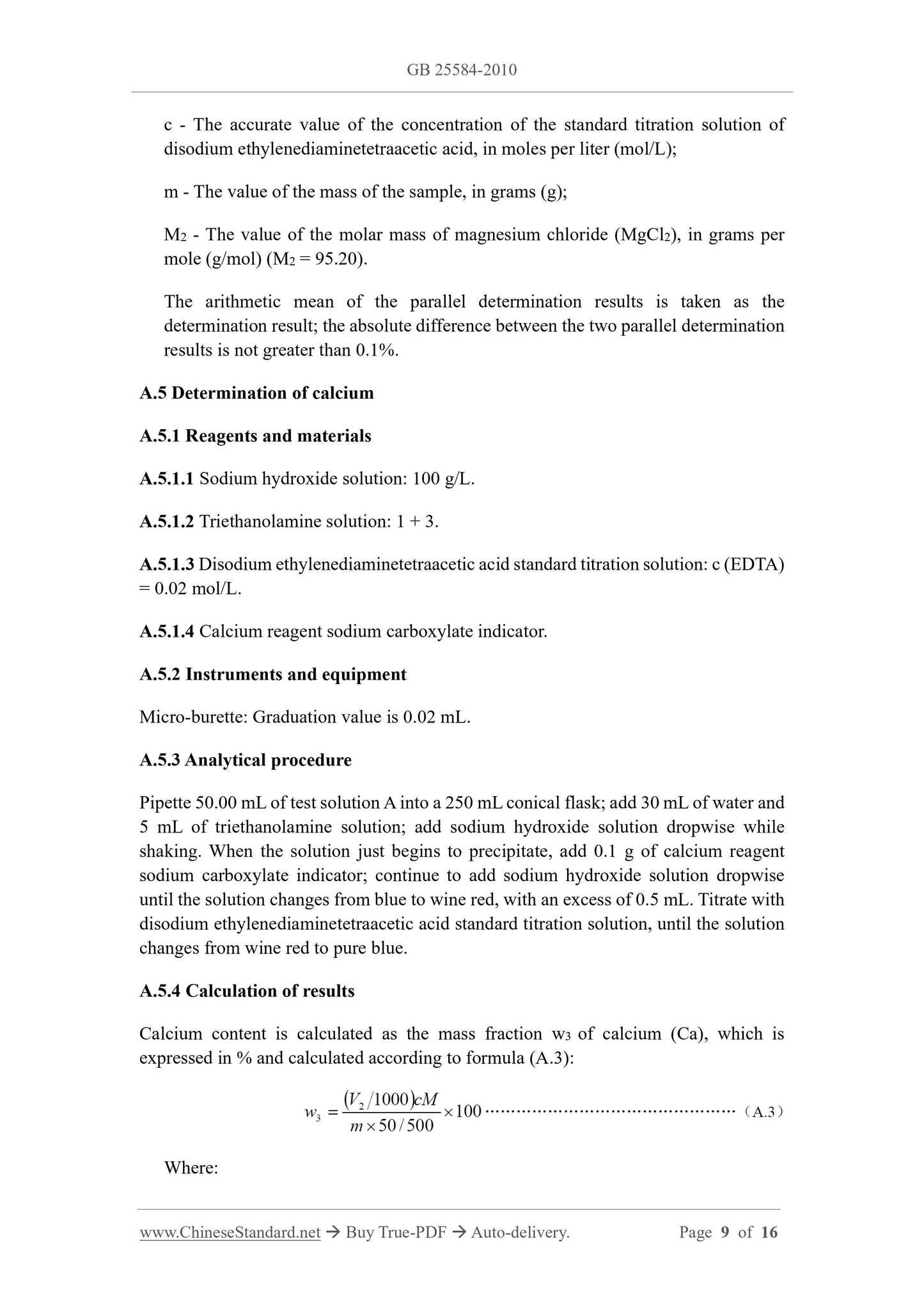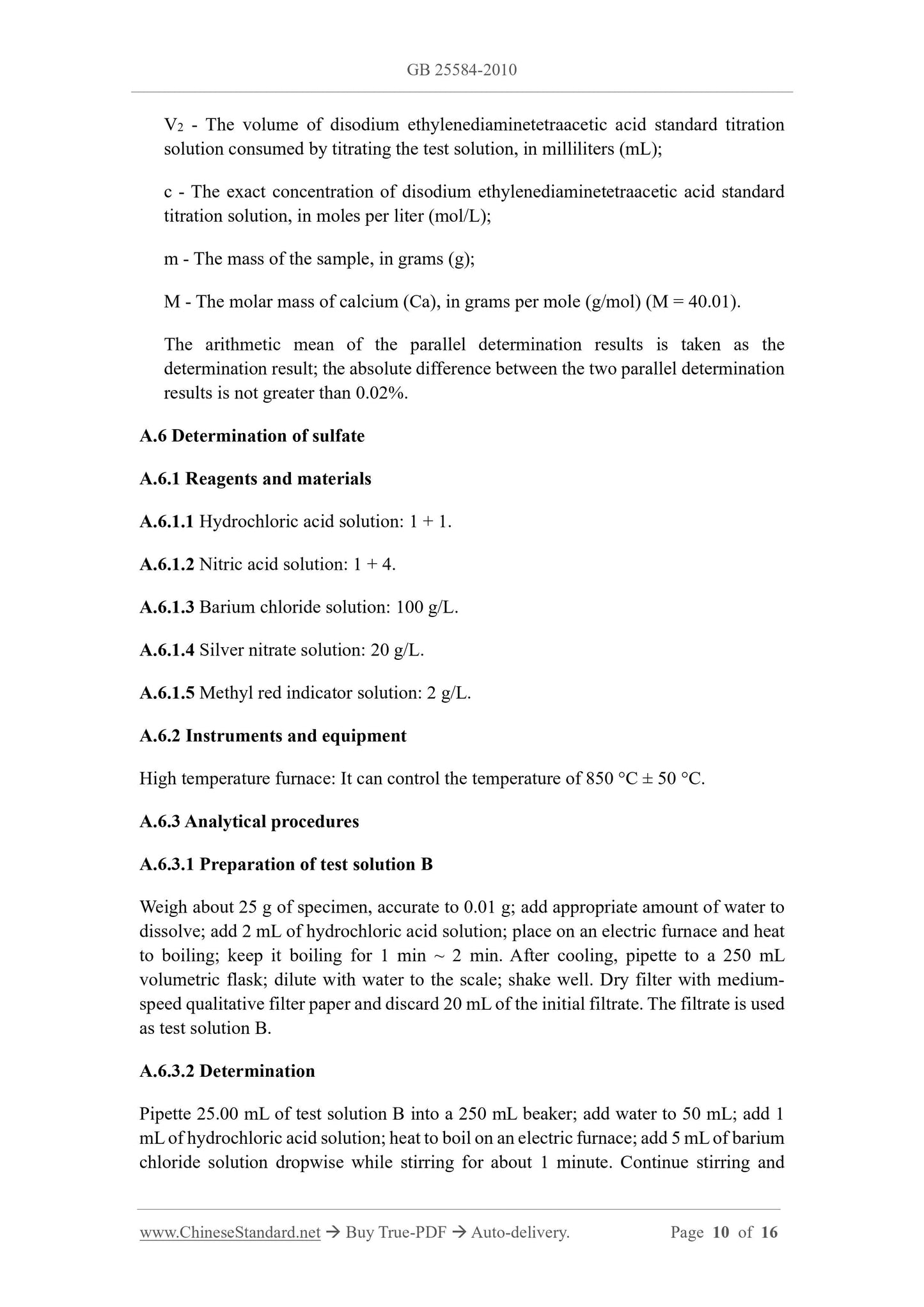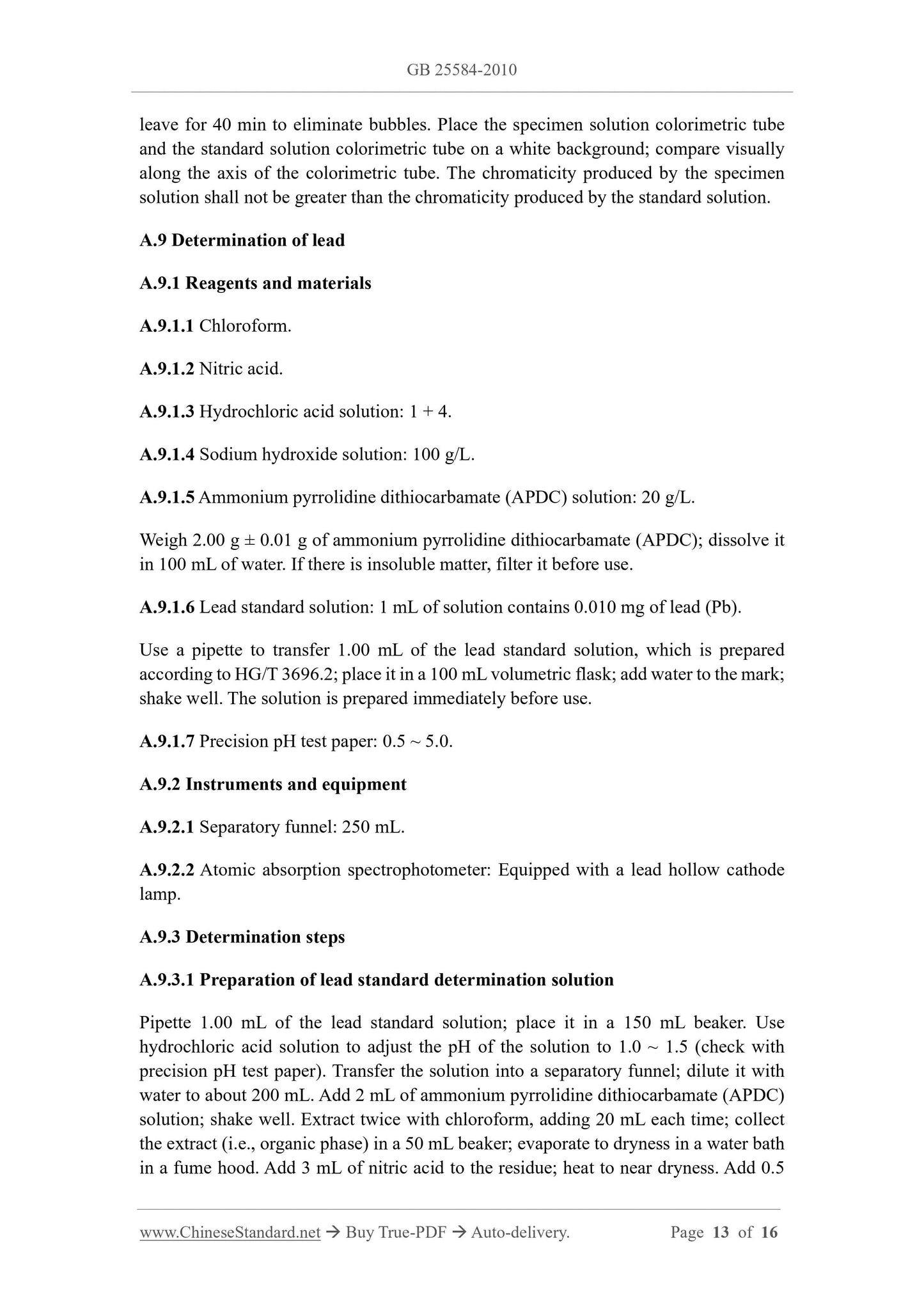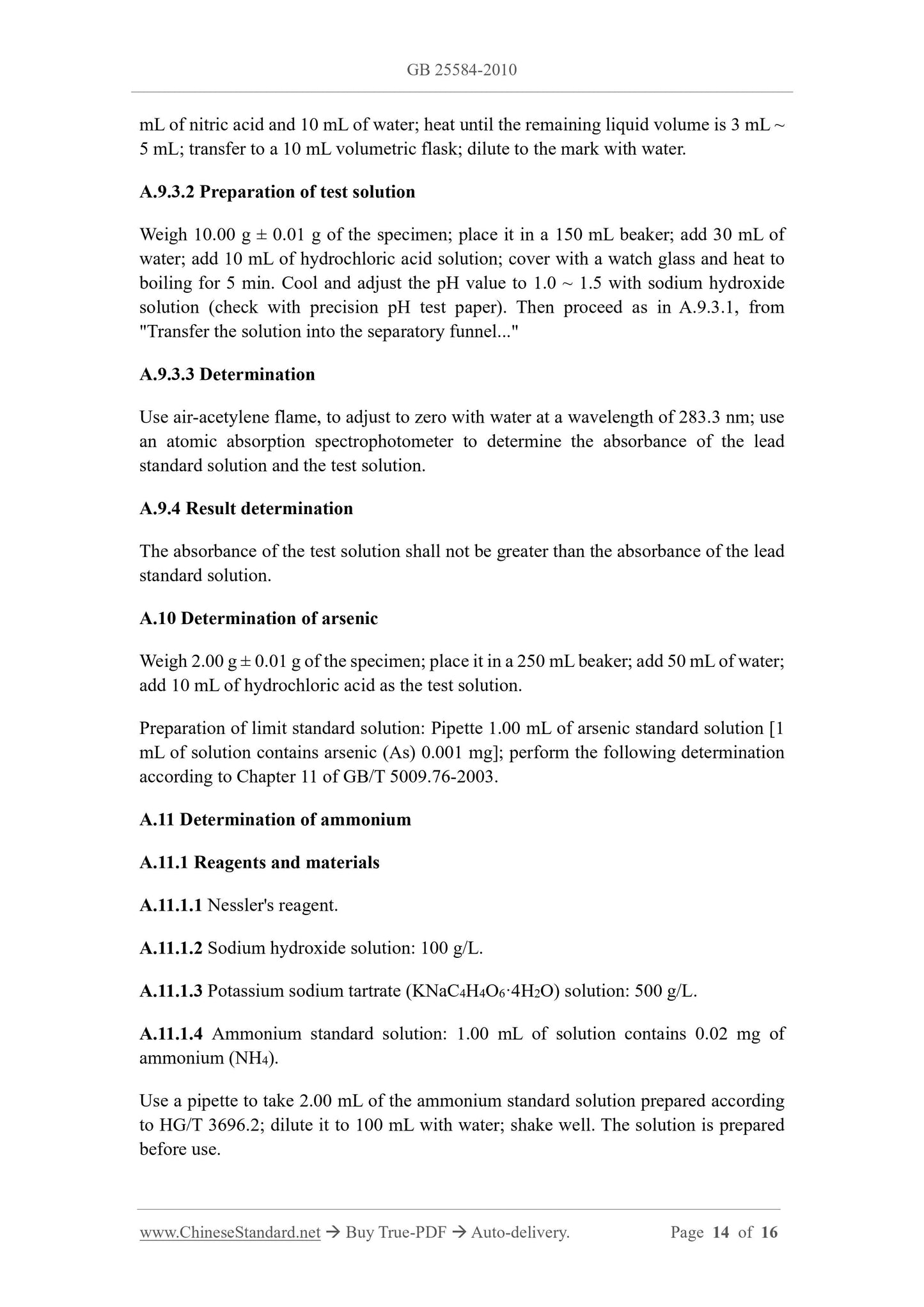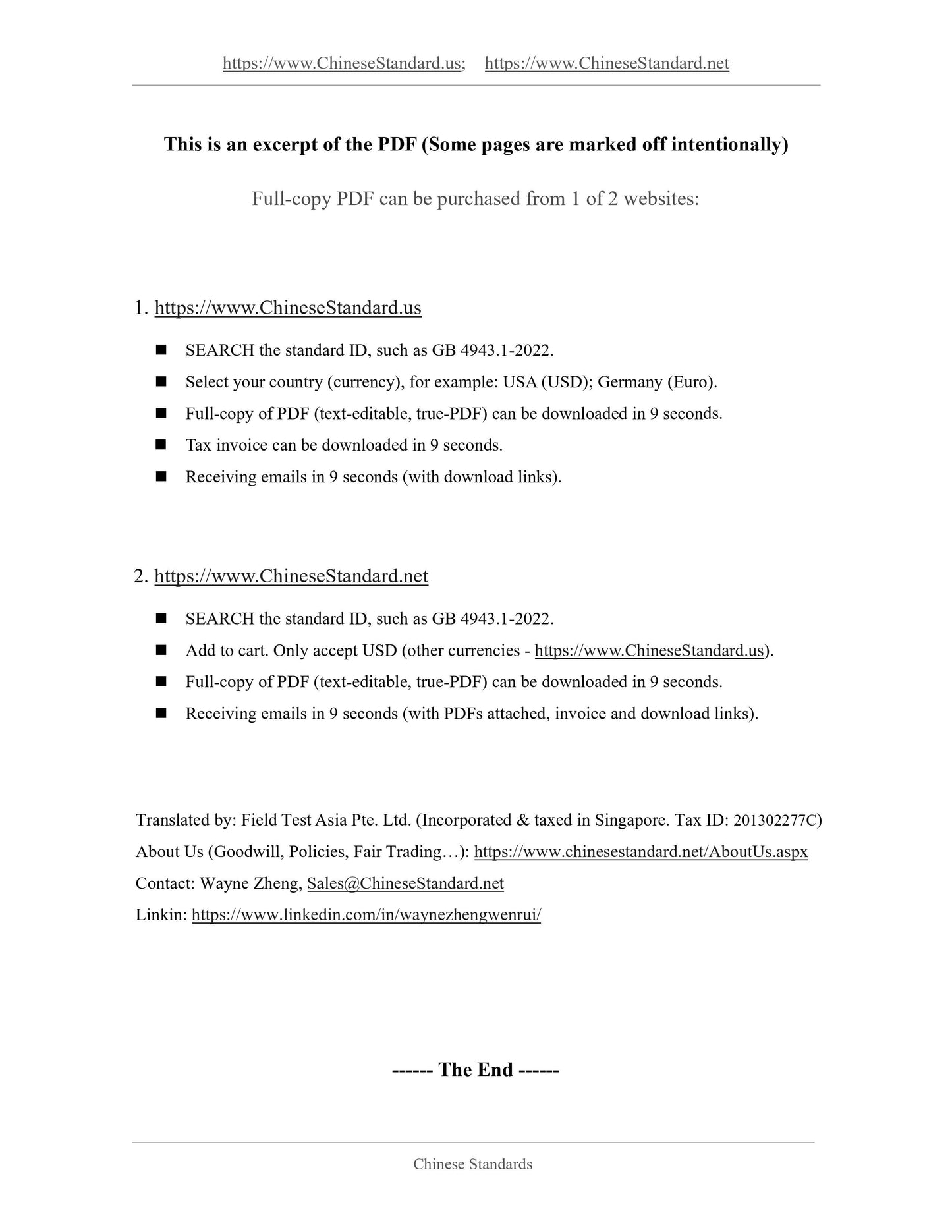1
/
of
10
www.ChineseStandard.us -- Field Test Asia Pte. Ltd.
GB 25584-2010 English PDF
GB 25584-2010 English PDF
Regular price
$125.00
Regular price
Sale price
$125.00
Unit price
/
per
Shipping calculated at checkout.
Couldn't load pickup availability
GB 25584-2010: National food safety standards of food additives magnesium chloride
Delivery: 9 seconds. Download (and Email) true-PDF + Invoice.
Get Quotation: Click GB 25584-2010 (Self-service in 1-minute)
Historical versions (Master-website): GB 25584-2010
Preview True-PDF (Reload/Scroll-down if blank)
GB 25584-2010
GB
NATIONAL STANDARD OF THE
PEOPLE’S REPUBLIC OF CHINA
National food safety standards of food additives magnesium
chloride
ISSUED ON: DECEMBER 21, 2010
IMPLEMENTED ON: FEBRUARY 21, 2011
Issued by: Ministry of Health of PRC
Table of Contents
Foreword ... 3
1 Scope ... 4
2 Normative references ... 4
3 Molecular formula and relative molecular mass ... 4
4 Technical requirements ... 4
Appendix A (Normative) Test method ... 6
National food safety standards of food additives magnesium
chloride
1 Scope
This standard applies to magnesium chloride, a food additive made from bischofite or
directly from salt production mother liquor.
2 Normative references
The following documents are essential to the application of this document. For the dated
documents, only the versions with the dates indicated are applicable to this document;
for the undated documents, only the latest version (including all the amendments) is
applicable to this standard.
3 Molecular formula and relative molecular mass
3.1 Molecular formula
MgCl2•nH2O (n = 0, 6)
3.2 Relative molecular mass
95.20 (n = 0) (according to the 2007 international relative atomic mass)
203.3 (n = 6) (according to the 2007 international relative atomic mass)
4 Technical requirements
4.1 Sensory requirements: It shall meet the requirements of Table 1.
Table 1 -- Sensory requirements
Item Requirements Inspection methods
Color White Take an appropriate amount of specimen; place it in a 50 mL beaker;
observe the color under natural light Organic state Flake or granular crystals
4.2 Physical and chemical indicators: It shall comply with the requirements of Table 2.
Appendix A
(Normative)
Test method
A.1 Warning
Some reagents used in the test method of this standard are corrosive, so the operator
must be careful! If splashed on the skin, rinse with water immediately; seek medical
attention immediately in severe cases. Operations using volatile organic solvents shall
be carried out in a fume hood.
A.2 General provisions
The reagents and water used in the test method of this standard, unless otherwise
specified, refer to analytical reagents and grade 3 water specified in GB/T 6682-2008.
The standard titration solution, impurity standard solution, preparation and product
required in the test, unless otherwise specified, shall be prepared in accordance with the
provisions of HG/T 3696.1, HG/T 3696.2, HG/T 3696.3.
A.3 Identification test
A.3.1 Reagents and materials
A.3.1.1 Ammonia solution: 2 + 3.
A.3.1.2 Ammonium chloride solution: 100 g/L.
A.3.1.3 Ammonium carbonate solution: 100 g/L.
A.3.1.4 Silver nitrate solution: 42 g/L.
A.3.1.5 Disodium hydrogen phosphate solution (Na2HPO3·12H2O): 160 g/L.
A.3.2 Analytical procedures
A.3.2.1 Identification of magnesium ions
Take about 0.2 g of the specimen; dissolve it in 10 mL of water. No precipitation is
produced when adding ammonium chloride solution and ammonium carbonate solution.
When adding disodium hydrogen phosphate solution, a white precipitate shall be
produced. Separate the precipitate and add ammonia solution. The precipitate shall not
dissolve.
A.3.2.2 Identification of chlorides
Take about 0.2 g of the specimen; dissolve it in 10 mL of water. Add silver nitrate
solution to produce a white precipitate. This precipitate is insoluble in nitric acid but
soluble in excess ammonia solution.
A.4 Determination of magnesium chloride
A.4.1 Method summary
Use triethanolamine to mask a small amount of trivalent iron, trivalent aluminum,
divalent manganese ions. When the pH is 10, use chrome black T as an indicator and
titrate the total amount of calcium and magnesium with disodium
ethylenediaminetetraacetic acid standard titration solution. Subtract the calcium content
from it, to calculate the magnesium chloride content.
A.4.2 Reagents and materials
A.4.2.1 Hydrochloric acid solution: 1 + 1.
A.4.2.2 Triethanolamine solution: 1 + 3.
A.4.2.3 Ammonia-ammonium chloride buffer solution (A) (pH≈10).
A.4.2.4 Silver nitrate solution: 10 g/L.
A.4.2.5 Disodium ethylenediaminetetraacetic acid standard titration solution: c(EDTA)
= 0.02 mol/L.
A.4.2.6 Chrome black T indicator.
A.4.3 Analytical procedure
A.4.3.1 Preparation of test solution A
Weigh about 10 g of the specimen, accurate to 0.000 2 g; place in a 250 mL beaker;
dissolve in 20 mL of water. Add 1 mL of hydrochloric acid solution; heat to boiling;
keep slight boiling for 1 min ~ 2 min. After cooling, transfer to a 250 mL volumetric
flask; dilute to the mark with water; shake well. This solution is test solution A. This
solution is retained for the determination of magnesium chloride content and calcium
content.
A.4.3.2 Determination
Pipette 25.00 mL of test solution A; place in a 250 mL volumetric flask; dilute to the
mark with water; shake well. Transfer 25.00 mL of the above solution into a 250 mL
conical flask; add 50 mL of water, 5 mL of triethanolamine solution, 10 mL of
ammonia-ammonium chloride buffer solution A, 0.1 g of chrome black T indicator;
titrate with disodium ethylenediaminetetraacetic acid standard titration solution, until
the solution changes from purple-red to pure blue.
c - The accurate value of the concentration of the standard titration solution of
disodium ethylenediaminetetraacetic acid, in moles per liter (mol/L);
m - The value of the mass of the sample, in grams (g);
M2 - The value of the molar mass of magnesium chloride (MgCl2), in grams per
mole (g/mol) (M2 = 95.20).
The arithmetic mean of the parallel determination results is taken as the
determination result; the absolute difference between the two parallel determination
results is not greater than 0.1%.
A.5 Determination of calcium
A.5.1 Reagents and materials
A.5.1.1 Sodium hydroxide solution: 100 g/L.
A.5.1.2 Triethanolamine solution: 1 + 3.
A.5.1.3 Disodium ethylenediaminetetraacetic acid standard titration solution: c (EDTA)
= 0.02 mol/L.
A.5.1.4 Calcium reagent sodium carboxylate indicator.
A.5.2 Instruments and equipment
Micro-burette: Graduation value is 0.02 mL.
A.5.3 Analytical procedure
Pipette 50.00 mL of test solution A into a 250 mL conical flask; add 30 mL of water and
5 mL of triethanolamine solution; add sodium hydroxide solution dropwise while
shaking. When the solution just begins to precipitate, add 0.1 g of calcium reagent
sodium carboxylate indicator; continue to add sodium hydroxide solution dropwise
until the solution changes from blue to wine red, with an excess of 0.5 mL. Titrate with
disodium ethylenediaminetetraacetic acid standard titration solution, until the solution
changes from wine red to pure blue.
A.5.4 Calculation of results
Calcium content is calculated as the mass fraction w3 of calcium (Ca), which is
expressed in % and calculated according to formula (A.3):
Where:
V2 - The volume of disodium ethylenediaminetetraacetic acid standard titration
solution consumed by titrating the test solution, in milliliters (mL);
c - The exact concentration of disodium ethylenediaminetetraacetic acid standard
titration solution, in moles per liter (mol/L);
m - The mass of the sample, in grams (g);
M - The molar mass of calcium (Ca), in grams per mole (g/mol) (M = 40.01).
The arithmetic mean of the parallel determination results is taken as the
determination result; the absolute difference between the two parallel determination
results is not greater than 0.02%.
A.6 Determination of sulfate
A.6.1 Reagents and materials
A.6.1.1 Hydrochloric acid solution: 1 + 1.
A.6.1.2 Nitric acid solution: 1 + 4.
A.6.1.3 Barium chloride solution: 100 g/L.
A.6.1.4 Silver nitrate solution: 20 g/L.
A.6.1.5 Methyl red indicator solution: 2 g/L.
A.6.2 Instruments and equipment
High temperature furnace: It can control the temperature of 850 °C ± 50 °C.
A.6.3 Analytical procedures
A.6.3.1 Preparation of test solution B
Weigh about 25 g of specimen, accurate to 0.01 g; add appropriate amount of water to
dissolve; add 2 mL of hydrochloric acid solution; place on an electric furnace and heat
to boiling; keep it boiling for 1 min ~ 2 min. After cooling, pipette to a 250 mL
volumetric flask; dilute with water to the scale; shake well. Dry filter with medium-
speed qualitative filter paper and discard 20 mL of the initial filtrate. The filtrate is used
as test solution B.
A.6.3.2 Determination
Pipette 25.00 mL of test solution B into a 250 mL beaker; add water to 50 mL; add 1
mL of hydrochloric acid solution; heat to boil on an electric furnace; add 5 mL of barium
chloride solution dropwise while stirring for about 1 minute. Continue stirring and
leave for 40 min to eliminate bubbles. Place the specimen solution colorimetric tube
and the standard solution colorimetric tube on a white background; compare visually
along the axis of the colorimetric tube. The chromaticity produced by the specimen
solution shall not be greater than the chromaticity produced by the standard solution.
A.9 Determination of lead
A.9.1 Reagents and materials
A.9.1.1 Chloroform.
A.9.1.2 Nitric acid.
A.9.1.3 Hydrochloric acid solution: 1 + 4.
A.9.1.4 Sodium hydroxide solution: 100 g/L.
A.9.1.5 Ammonium pyrrolidine dithiocarbamate (APDC) solution: 20 g/L.
Weigh 2.00 g ± 0.01 g of ammonium pyrrolidine dithiocarbamate (APDC); dissolve it
in 100 mL of water. If there is insoluble matter, filter it before use.
A.9.1.6 Lead standard solution: 1 mL of solution contains 0.010 mg of lead (Pb).
Use a pipette to transfer 1.00 mL of the lead standard solution, which is prepared
according to HG/T 3696.2; place it in a 100 mL volumetric flask; add water to the mark;
shake well. The solution is prepared immediately before use.
A.9.1.7 Precision pH test paper: 0.5 ~ 5.0.
A.9.2 Instruments and equipment
A.9.2.1 Separatory funnel: 250 mL.
A.9.2.2 Atomic absorption spectrophotometer: Equipped with a lead hollow cathode
lamp.
A.9.3 Determination steps
A.9.3.1 Preparation of lead standard determination solution
Pipette 1.00 mL of the lead standard solution; place it in a 150 mL beaker. Use
hydrochloric acid solution to adjust the pH of the solution to 1.0 ~ 1.5 (check with
precision pH test paper). Transfer the solution into a separatory funnel; dilute it with
water to about 200 mL. Add 2 mL of ammonium pyrrolidine dithiocarbamate (APDC)
solution; shake well. Extract twice with chloroform, adding 20 mL each time; collect
the extract (i.e., organic phase) in a 50 mL beaker; evaporate to dryness in a water bath
in a fume hood. Add 3 mL of nitric acid to the residue; heat to near dryness. Add 0.5
mL of nitric acid and 10 mL of water; heat until the remaining liquid volume is 3 mL ~
5 mL; transfer to a 10 mL volumetric flask; dilute to the mark with water.
A.9.3.2 Preparation of test solution
Weigh 10.00 g ± 0.01 g of the specimen; place it in a 150 mL beaker; add 30 mL of
water; add 10 mL of hydrochloric acid solution; cover with a watch glass and heat to
boiling for 5 min. Cool and adjust the pH value to 1.0 ~ 1.5 with sodium hydroxide
solution (check with precision pH test paper). Then proceed as in A.9.3.1, from
"Transfer the solution into the separatory funnel..."
A.9.3.3 Determination
Use air-acetylene flame, to adjust to zero with water at a wavelength of 283.3 nm; use
an atomic absorption spectrophotometer to determine the absorbance of the lead
standard solution and the test solution.
A.9.4 Result determination
The absorbance of the test solution shall not be greater than the absorbance of the lead
standard solution.
A.10 Determination of arsenic
Weigh 2.00 g ± 0.01 g of the specimen; place it in a 250 mL beaker; add 50 mL of water;
add 10 mL of hydrochloric acid as the test solution.
Preparation of limit standard solution: Pipette 1.00 mL of arsenic standard solution [1
mL of solution contains arsenic (As) 0.001 mg]; perform the following determination
according to Chapter 11 of GB/T 5009.76-2003.
A.11 Determination of ammonium
A.11.1 Reagents and materials
A.11.1.1 Nessler's reagent.
A.11.1.2 Sodium hydroxide solution: 100 g/L.
A.11.1.3 Potassium sodium tartrate (KNaC4H4O6·4H2O) solution: 500 g/L.
A.11.1.4 Ammonium standard solution: 1.00 mL of solution contains 0.02 mg of
ammonium (NH4).
Use a pipette to take 2.00 mL of the ammonium standard solution prepared according
to HG/T 3696.2; dilute it to 100 mL with water; shake well. The solution is prepared
before use.
GB 25584-2010
GB
NATIONAL STANDARD OF THE
PEOPLE’S REPUBLIC OF CHINA
National food safety standards of food additives magnesium
chloride
ISSUED ON: DECEMBER 21, 2010
IMPLEMENTED ON: FEBRUARY 21, 2011
Issued by: Ministry of Health of PRC
Table of Contents
Foreword ... 3
1 Scope ... 4
2 Normative references ... 4
3 Molecular formula and relative molecular mass ... 4
4 Technical requirements ... 4
Appendix A (Normative) Test method ... 6
National food safety standards of food additives magnesium
chloride
1 Scope
This standard applies to magnesium chloride, a food additive made from bischofite or
directly from salt production mother liquor.
2 Normative references
The following documents are essential to the application of this document. For the dated
documents, only the versions with the dates indicated are applicable to this document;
for the undated documents, only the latest version (including all the amendments) is
applicable to this standard.
3 Molecular formula and relative molecular mass
3.1 Molecular formula
MgCl2•nH2O (n = 0, 6)
3.2 Relative molecular mass
95.20 (n = 0) (according to the 2007 international relative atomic mass)
203.3 (n = 6) (according to the 2007 international relative atomic mass)
4 Technical requirements
4.1 Sensory requirements: It shall meet the requirements of Table 1.
Table 1 -- Sensory requirements
Item Requirements Inspection methods
Color White Take an appropriate amount of specimen; place it i...
Delivery: 9 seconds. Download (and Email) true-PDF + Invoice.
Get Quotation: Click GB 25584-2010 (Self-service in 1-minute)
Historical versions (Master-website): GB 25584-2010
Preview True-PDF (Reload/Scroll-down if blank)
GB 25584-2010
GB
NATIONAL STANDARD OF THE
PEOPLE’S REPUBLIC OF CHINA
National food safety standards of food additives magnesium
chloride
ISSUED ON: DECEMBER 21, 2010
IMPLEMENTED ON: FEBRUARY 21, 2011
Issued by: Ministry of Health of PRC
Table of Contents
Foreword ... 3
1 Scope ... 4
2 Normative references ... 4
3 Molecular formula and relative molecular mass ... 4
4 Technical requirements ... 4
Appendix A (Normative) Test method ... 6
National food safety standards of food additives magnesium
chloride
1 Scope
This standard applies to magnesium chloride, a food additive made from bischofite or
directly from salt production mother liquor.
2 Normative references
The following documents are essential to the application of this document. For the dated
documents, only the versions with the dates indicated are applicable to this document;
for the undated documents, only the latest version (including all the amendments) is
applicable to this standard.
3 Molecular formula and relative molecular mass
3.1 Molecular formula
MgCl2•nH2O (n = 0, 6)
3.2 Relative molecular mass
95.20 (n = 0) (according to the 2007 international relative atomic mass)
203.3 (n = 6) (according to the 2007 international relative atomic mass)
4 Technical requirements
4.1 Sensory requirements: It shall meet the requirements of Table 1.
Table 1 -- Sensory requirements
Item Requirements Inspection methods
Color White Take an appropriate amount of specimen; place it in a 50 mL beaker;
observe the color under natural light Organic state Flake or granular crystals
4.2 Physical and chemical indicators: It shall comply with the requirements of Table 2.
Appendix A
(Normative)
Test method
A.1 Warning
Some reagents used in the test method of this standard are corrosive, so the operator
must be careful! If splashed on the skin, rinse with water immediately; seek medical
attention immediately in severe cases. Operations using volatile organic solvents shall
be carried out in a fume hood.
A.2 General provisions
The reagents and water used in the test method of this standard, unless otherwise
specified, refer to analytical reagents and grade 3 water specified in GB/T 6682-2008.
The standard titration solution, impurity standard solution, preparation and product
required in the test, unless otherwise specified, shall be prepared in accordance with the
provisions of HG/T 3696.1, HG/T 3696.2, HG/T 3696.3.
A.3 Identification test
A.3.1 Reagents and materials
A.3.1.1 Ammonia solution: 2 + 3.
A.3.1.2 Ammonium chloride solution: 100 g/L.
A.3.1.3 Ammonium carbonate solution: 100 g/L.
A.3.1.4 Silver nitrate solution: 42 g/L.
A.3.1.5 Disodium hydrogen phosphate solution (Na2HPO3·12H2O): 160 g/L.
A.3.2 Analytical procedures
A.3.2.1 Identification of magnesium ions
Take about 0.2 g of the specimen; dissolve it in 10 mL of water. No precipitation is
produced when adding ammonium chloride solution and ammonium carbonate solution.
When adding disodium hydrogen phosphate solution, a white precipitate shall be
produced. Separate the precipitate and add ammonia solution. The precipitate shall not
dissolve.
A.3.2.2 Identification of chlorides
Take about 0.2 g of the specimen; dissolve it in 10 mL of water. Add silver nitrate
solution to produce a white precipitate. This precipitate is insoluble in nitric acid but
soluble in excess ammonia solution.
A.4 Determination of magnesium chloride
A.4.1 Method summary
Use triethanolamine to mask a small amount of trivalent iron, trivalent aluminum,
divalent manganese ions. When the pH is 10, use chrome black T as an indicator and
titrate the total amount of calcium and magnesium with disodium
ethylenediaminetetraacetic acid standard titration solution. Subtract the calcium content
from it, to calculate the magnesium chloride content.
A.4.2 Reagents and materials
A.4.2.1 Hydrochloric acid solution: 1 + 1.
A.4.2.2 Triethanolamine solution: 1 + 3.
A.4.2.3 Ammonia-ammonium chloride buffer solution (A) (pH≈10).
A.4.2.4 Silver nitrate solution: 10 g/L.
A.4.2.5 Disodium ethylenediaminetetraacetic acid standard titration solution: c(EDTA)
= 0.02 mol/L.
A.4.2.6 Chrome black T indicator.
A.4.3 Analytical procedure
A.4.3.1 Preparation of test solution A
Weigh about 10 g of the specimen, accurate to 0.000 2 g; place in a 250 mL beaker;
dissolve in 20 mL of water. Add 1 mL of hydrochloric acid solution; heat to boiling;
keep slight boiling for 1 min ~ 2 min. After cooling, transfer to a 250 mL volumetric
flask; dilute to the mark with water; shake well. This solution is test solution A. This
solution is retained for the determination of magnesium chloride content and calcium
content.
A.4.3.2 Determination
Pipette 25.00 mL of test solution A; place in a 250 mL volumetric flask; dilute to the
mark with water; shake well. Transfer 25.00 mL of the above solution into a 250 mL
conical flask; add 50 mL of water, 5 mL of triethanolamine solution, 10 mL of
ammonia-ammonium chloride buffer solution A, 0.1 g of chrome black T indicator;
titrate with disodium ethylenediaminetetraacetic acid standard titration solution, until
the solution changes from purple-red to pure blue.
c - The accurate value of the concentration of the standard titration solution of
disodium ethylenediaminetetraacetic acid, in moles per liter (mol/L);
m - The value of the mass of the sample, in grams (g);
M2 - The value of the molar mass of magnesium chloride (MgCl2), in grams per
mole (g/mol) (M2 = 95.20).
The arithmetic mean of the parallel determination results is taken as the
determination result; the absolute difference between the two parallel determination
results is not greater than 0.1%.
A.5 Determination of calcium
A.5.1 Reagents and materials
A.5.1.1 Sodium hydroxide solution: 100 g/L.
A.5.1.2 Triethanolamine solution: 1 + 3.
A.5.1.3 Disodium ethylenediaminetetraacetic acid standard titration solution: c (EDTA)
= 0.02 mol/L.
A.5.1.4 Calcium reagent sodium carboxylate indicator.
A.5.2 Instruments and equipment
Micro-burette: Graduation value is 0.02 mL.
A.5.3 Analytical procedure
Pipette 50.00 mL of test solution A into a 250 mL conical flask; add 30 mL of water and
5 mL of triethanolamine solution; add sodium hydroxide solution dropwise while
shaking. When the solution just begins to precipitate, add 0.1 g of calcium reagent
sodium carboxylate indicator; continue to add sodium hydroxide solution dropwise
until the solution changes from blue to wine red, with an excess of 0.5 mL. Titrate with
disodium ethylenediaminetetraacetic acid standard titration solution, until the solution
changes from wine red to pure blue.
A.5.4 Calculation of results
Calcium content is calculated as the mass fraction w3 of calcium (Ca), which is
expressed in % and calculated according to formula (A.3):
Where:
V2 - The volume of disodium ethylenediaminetetraacetic acid standard titration
solution consumed by titrating the test solution, in milliliters (mL);
c - The exact concentration of disodium ethylenediaminetetraacetic acid standard
titration solution, in moles per liter (mol/L);
m - The mass of the sample, in grams (g);
M - The molar mass of calcium (Ca), in grams per mole (g/mol) (M = 40.01).
The arithmetic mean of the parallel determination results is taken as the
determination result; the absolute difference between the two parallel determination
results is not greater than 0.02%.
A.6 Determination of sulfate
A.6.1 Reagents and materials
A.6.1.1 Hydrochloric acid solution: 1 + 1.
A.6.1.2 Nitric acid solution: 1 + 4.
A.6.1.3 Barium chloride solution: 100 g/L.
A.6.1.4 Silver nitrate solution: 20 g/L.
A.6.1.5 Methyl red indicator solution: 2 g/L.
A.6.2 Instruments and equipment
High temperature furnace: It can control the temperature of 850 °C ± 50 °C.
A.6.3 Analytical procedures
A.6.3.1 Preparation of test solution B
Weigh about 25 g of specimen, accurate to 0.01 g; add appropriate amount of water to
dissolve; add 2 mL of hydrochloric acid solution; place on an electric furnace and heat
to boiling; keep it boiling for 1 min ~ 2 min. After cooling, pipette to a 250 mL
volumetric flask; dilute with water to the scale; shake well. Dry filter with medium-
speed qualitative filter paper and discard 20 mL of the initial filtrate. The filtrate is used
as test solution B.
A.6.3.2 Determination
Pipette 25.00 mL of test solution B into a 250 mL beaker; add water to 50 mL; add 1
mL of hydrochloric acid solution; heat to boil on an electric furnace; add 5 mL of barium
chloride solution dropwise while stirring for about 1 minute. Continue stirring and
leave for 40 min to eliminate bubbles. Place the specimen solution colorimetric tube
and the standard solution colorimetric tube on a white background; compare visually
along the axis of the colorimetric tube. The chromaticity produced by the specimen
solution shall not be greater than the chromaticity produced by the standard solution.
A.9 Determination of lead
A.9.1 Reagents and materials
A.9.1.1 Chloroform.
A.9.1.2 Nitric acid.
A.9.1.3 Hydrochloric acid solution: 1 + 4.
A.9.1.4 Sodium hydroxide solution: 100 g/L.
A.9.1.5 Ammonium pyrrolidine dithiocarbamate (APDC) solution: 20 g/L.
Weigh 2.00 g ± 0.01 g of ammonium pyrrolidine dithiocarbamate (APDC); dissolve it
in 100 mL of water. If there is insoluble matter, filter it before use.
A.9.1.6 Lead standard solution: 1 mL of solution contains 0.010 mg of lead (Pb).
Use a pipette to transfer 1.00 mL of the lead standard solution, which is prepared
according to HG/T 3696.2; place it in a 100 mL volumetric flask; add water to the mark;
shake well. The solution is prepared immediately before use.
A.9.1.7 Precision pH test paper: 0.5 ~ 5.0.
A.9.2 Instruments and equipment
A.9.2.1 Separatory funnel: 250 mL.
A.9.2.2 Atomic absorption spectrophotometer: Equipped with a lead hollow cathode
lamp.
A.9.3 Determination steps
A.9.3.1 Preparation of lead standard determination solution
Pipette 1.00 mL of the lead standard solution; place it in a 150 mL beaker. Use
hydrochloric acid solution to adjust the pH of the solution to 1.0 ~ 1.5 (check with
precision pH test paper). Transfer the solution into a separatory funnel; dilute it with
water to about 200 mL. Add 2 mL of ammonium pyrrolidine dithiocarbamate (APDC)
solution; shake well. Extract twice with chloroform, adding 20 mL each time; collect
the extract (i.e., organic phase) in a 50 mL beaker; evaporate to dryness in a water bath
in a fume hood. Add 3 mL of nitric acid to the residue; heat to near dryness. Add 0.5
mL of nitric acid and 10 mL of water; heat until the remaining liquid volume is 3 mL ~
5 mL; transfer to a 10 mL volumetric flask; dilute to the mark with water.
A.9.3.2 Preparation of test solution
Weigh 10.00 g ± 0.01 g of the specimen; place it in a 150 mL beaker; add 30 mL of
water; add 10 mL of hydrochloric acid solution; cover with a watch glass and heat to
boiling for 5 min. Cool and adjust the pH value to 1.0 ~ 1.5 with sodium hydroxide
solution (check with precision pH test paper). Then proceed as in A.9.3.1, from
"Transfer the solution into the separatory funnel..."
A.9.3.3 Determination
Use air-acetylene flame, to adjust to zero with water at a wavelength of 283.3 nm; use
an atomic absorption spectrophotometer to determine the absorbance of the lead
standard solution and the test solution.
A.9.4 Result determination
The absorbance of the test solution shall not be greater than the absorbance of the lead
standard solution.
A.10 Determination of arsenic
Weigh 2.00 g ± 0.01 g of the specimen; place it in a 250 mL beaker; add 50 mL of water;
add 10 mL of hydrochloric acid as the test solution.
Preparation of limit standard solution: Pipette 1.00 mL of arsenic standard solution [1
mL of solution contains arsenic (As) 0.001 mg]; perform the following determination
according to Chapter 11 of GB/T 5009.76-2003.
A.11 Determination of ammonium
A.11.1 Reagents and materials
A.11.1.1 Nessler's reagent.
A.11.1.2 Sodium hydroxide solution: 100 g/L.
A.11.1.3 Potassium sodium tartrate (KNaC4H4O6·4H2O) solution: 500 g/L.
A.11.1.4 Ammonium standard solution: 1.00 mL of solution contains 0.02 mg of
ammonium (NH4).
Use a pipette to take 2.00 mL of the ammonium standard solution prepared according
to HG/T 3696.2; dilute it to 100 mL with water; shake well. The solution is prepared
before use.
GB 25584-2010
GB
NATIONAL STANDARD OF THE
PEOPLE’S REPUBLIC OF CHINA
National food safety standards of food additives magnesium
chloride
ISSUED ON: DECEMBER 21, 2010
IMPLEMENTED ON: FEBRUARY 21, 2011
Issued by: Ministry of Health of PRC
Table of Contents
Foreword ... 3
1 Scope ... 4
2 Normative references ... 4
3 Molecular formula and relative molecular mass ... 4
4 Technical requirements ... 4
Appendix A (Normative) Test method ... 6
National food safety standards of food additives magnesium
chloride
1 Scope
This standard applies to magnesium chloride, a food additive made from bischofite or
directly from salt production mother liquor.
2 Normative references
The following documents are essential to the application of this document. For the dated
documents, only the versions with the dates indicated are applicable to this document;
for the undated documents, only the latest version (including all the amendments) is
applicable to this standard.
3 Molecular formula and relative molecular mass
3.1 Molecular formula
MgCl2•nH2O (n = 0, 6)
3.2 Relative molecular mass
95.20 (n = 0) (according to the 2007 international relative atomic mass)
203.3 (n = 6) (according to the 2007 international relative atomic mass)
4 Technical requirements
4.1 Sensory requirements: It shall meet the requirements of Table 1.
Table 1 -- Sensory requirements
Item Requirements Inspection methods
Color White Take an appropriate amount of specimen; place it i...
Share
